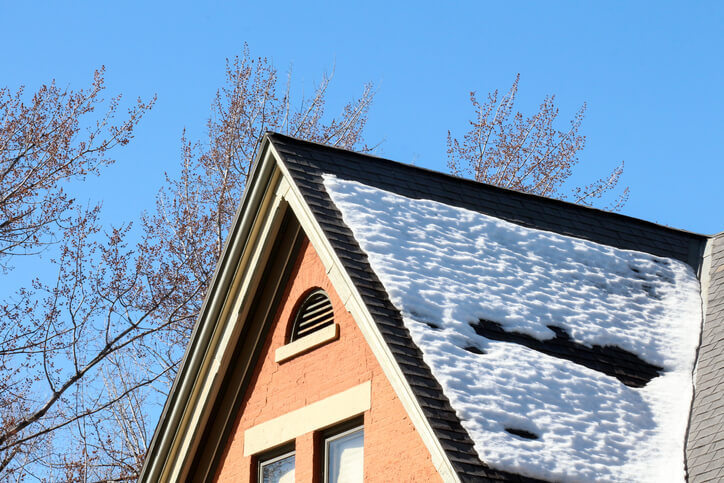We all know that April showers are famous for bringing May flowers. But the spring rains that bring our favorite blooms also can lead to serious flooding. For instance, did you know just 4 to 7 inches of rain can cause overflows in rivers, leading to extensive flooding?
Even if you don’t live near any bodies of water, you can still be impacted by spring flooding. In fact, nearly 40% of flood claims come from areas not considered to be high-risk flood areas. The snow, ice or rain in your own backyard can lead to flooding in your home, causing unexpected and sometimes serious water damage.
When the average payout for a flood insurance claim is over $50,000, it’s important to make sure you’re prepared and protected for spring flooding. Keep reading to make sure you’re ready:
What Causes Spring Flooding?
In the western U.S., as much as 75% of the water supply derives from melting snow, which releases water into rivers during the warmer seasons, according to the USGS.
One of the problems, according to FEMA, is that warmer temperatures cause snow to melt and create runoff quickly. With the land still frozen, water easily runs off the surface and fills lakes and streams. These bodies of water begin to spill over their banks. Add seasonal storms to the mix, and the result can be springtime floods.

“Each cubic foot of compacted snow contains gallons of water.”
Many people who do not live near water incorrectly assume that spring flooding will not affect them.
Flooding from spring rains and snow melt is not limited to coastal and riverside areas. When snow melt occurs in your yard, especially when it’s followed by heavy spring rains, the water must find a place to go. Often, it will flow into a home’s basement, crawl space or lower level.
Water always runs from higher ground to lower ground. If the ground around your home becomes saturated, the water may start seeping into your home through:
- Windows
- Doors
- Cracks in the foundation
Even if you live in an area that does not get significant snowfall, spring flooding can still be a concern when heavy rains come, which is why it’s crucial to know the facts and be ready to protect your home.
6 Tips to Prepare for Spring Floods
It may not be possible to prevent water damage under all circumstances, but there are a number of steps homeowners can take to prepare their homes for common flooding caused by spring thaw. Consider taking some or all of the following precautions:
1
Install a Pump
A sump pump or sewer backflow valve can help keep water from pooling in your basement. It may be a good idea to have a battery-powered backup pump on hand, in case a storm causes a power outage.
2
Check for Leaks
Routinely check around all doors and windows for potential leaks. Inspect your foundation to see if you can find any cracks that may allow water to seep in. If you do see cracks or leaks, have them repaired as soon as possible. While you can repair a foundation crack yourself by sealing it with hydraulic cement, such do-it-yourself solutions are usually only temporary. Within a few years, you’ll need to call a foundation expert.
3
Remove Debris
It’s common for leaves, branches and other debris to collect in window wells, gutters, downspouts and other areas around your home. Be sure to remove wet leaves and other debris, as it can slowly add pressure and wear away paint, rot wood, or lead to cracks or leaks. When debris is allowed to pile up in gutters and downspouts, water will run off the roof, pooling near your foundation where it can cause mold growth and foundation cracks and damage. If gutter debris freezes and causes ice dams, it may prevent water from draining properly and provide opportunities for water to seep into your home.
4
Check Your Landscape
If at all possible, the grading of your yard should encourage water to flow away from your home, not toward your home. If there are areas where your lawn or landscaping dips toward your home, regrade those areas to direct water away from your house. Also, make sure you trim trees and bushes near your home so that branches aren’t leaning on or over the house. Remove tree trimmings or grass clippings from next to the house, as they could hold water and encourage leaks.

5
Inspect Your Roof
It’s important to keep your roof in good condition. If you’ve left fall leaves to pile up on your roof, they will gradually wear down the shingles. When melting snow and rain come, you’ll be more likely to experience a leak. If you think you may have shingles missing or damage to your roof, call a local roofing company. Most will inspect your roof for no charge to see if you need to make a repair.
6
Remove Valuables From Lower Levels
If you use your basement or cellar for storage, avoid keeping electronics, photo albums or other items down there as they could be damaged by water — and difficult to replace.
Consider Flood Insurance
Standard homeowner’s insurance policies do not cover flooding. Instead, homeowners who want to protect their homes against flood damage must purchase a separate flood insurance policy. It’s important to understand what flood insurance covers, for example, in a basement.
Flood insurance sold by insurance companies is regulated by the National Flood Insurance Program (NFIP). Regardless of which insurance provider you choose, your flood insurance rates will be set by the national flood program. Consider choosing the provider you believe will offer the best service for you and your home especially when it comes to filing a claim.
A flood insurance policy becomes effective 30 days after the date of purchase. Flood insurance is available for purchase in communities that participate in the NFIP. To find out whether your community is a participant, search for it in the NFIP’s Community Status Book.
Even if you’re not a homeowner, you may want to consider purchasing a flood insurance policy. Flood coverage can be added to renters and condo policies, helping ensure that your belongings would be protected from flood water damage.








Hartford quotes are competitive .
How do I acquire FEMA Flood Insurance
Hi Alice! For more information or to request a flood quote, please call our flood department at 1-800-296-7542. Our hours are Mondays – Fridays, 8am – 6pm. Thank you!
I already have auto insurance with Hartford.I would like renter,and flood added with my renter insurance. I would like a quote please. Thank You Linda ORISE Mills
Hi Linda! To request a renters quote, please call a representative at 888-413-8970. From there, a representative can also direct you to our floor department. Or, if you’d rather start with flood insurance, you can call our flood department directly at 1-800-296-7542. Thanks!
Hi. I would like an estimate on fluid insurance to have for peace of mind.
Thank you
Linda Hong
Hi Linda! For more information or to request a flood quote, please call our flood department at 1-800-296-7542. Our hours are Mondays – Fridays, 8am – 6pm. Thank you!